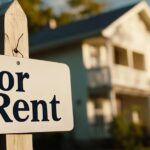On Monday, Donald J. Trump was inaugurated as the 47th President of the United States, and wasted no time in ushering in his “Golden Age of America” by signing a series of executive actions. Just hours after returning to the White House, Trump revoked 78 policies signed under President Joe Biden’s term through executive orders, a number of which will impact the housing industry.
Among Trump’s executive orders taking aim at immigration policies, withdrawal from the Paris Climate Agreement and World Health Organization (WHO), and actions pardoning approximately 1,500 charged in the January 6, 2021 attack on the U.S. Capitol, the 47th U.S. President turned his focus toward regulatory requirements that account for 25% of the cost of constructing a new home.
“I hereby order the heads of all executive departments and agencies to deliver emergency price relief, consistent with applicable law, to the American people and increase the prosperity of the American worker,” stated Trump in his executive order. “This shall include pursuing appropriate actions to: lower the cost of housing and expand housing supply; eliminate unnecessary administrative expenses and rent-seeking practices that increase healthcare costs; eliminate counterproductive requirements that raise the costs of home appliances; create employment opportunities for American workers, including drawing discouraged workers into the labor force; and eliminate harmful, coercive ‘climate’ policies that increase the costs of food and fuel. Within 30 days of the date of this memorandum, the Assistant to the President for Economic Policy shall report to me and every 30 days thereafter, on the status of the implementation of this memorandum.”
Curbing Construction Costs
According to an analysis by Associated Builders and Contractors, construction input prices ticked up 0.3% in October, driven primarily by increased costs across all energy subcategories.
As prices of raw materials have risen based on short supply and ties to tariffs, industry trade groups have thrown their expertise into the ring in an attempt to solve the affordability crisis faced by potential home buyers.
In focusing on the regulatory requirements that account for the cost of new construction, Daren Blomquist, VP, Market Economics at Auction.com, commented: “The philosophical shift toward deregulation should boost confidence in the short term with builders, renovators, and others involved in providing new supply to the housing market. But the devil, as always, will be in the details that come out of this philosophical shift over the next several months. And it will also be important to consider any unintended consequences from this shift toward deregulation. To use an admittedly oversimplified example, if deregulation leads to the average price of a home falling by $50,000, that could negatively impact the equity of existing homeowners.”
Carl Harris, Chairman of the National Association of Home Builders (NAHB) and a custom home builder from Wichita, Kansas, issued the following statement after President Trump issued his executive order: “NAHB commends President Trump for acting on day one to make housing a national priority by issuing an executive order that seeks to lower the cost and increase the supply of housing. President Trump understands that America is facing a housing affordability crisis and the only way out of this crisis is to remove barriers like unnecessary and costly regulations that are raising housing costs and preventing builders from building more attainable, affordable housing. NAHB has released a 10-point housing plan to remove the impediments to increasing the nation’s housing supply and we look forward to working with the Trump administration and Congress to enact sound policies that will allow builders to boost housing production and affordability.”
Released last May, “NAHB’s 10-Point Plan to Tame Shelter Inflation, Ease the Housing Affordability Crisis” focuses on 10 market concerns that can be remedied to correct affordability issues, including:
- Eliminate excess regulations
- Promote careers in skilled trades
- Fixing material supply chains
- Passing federal tax legislation to expand the production of affordable and attainable housing
- Overturning inefficient zoning rules
- Alleviating permitting roadblocks
- Adopting reasonable and cost-effective building codes
- Reducing local impact fees and other upfront taxes associated with housing construction
- Making it easier for developers to finance new housing
- Updating employment policies to promote flexibility and opportunity
Blomquist added, “The shift toward deregulation could certainly help to release some deferred foreclosure inventory as well, depending on the people and policies put in place at key government agencies like FHA, FHFA and CFPB. While there is not a massive backlog of foreclosures waiting in the wings, the inventory of seriously delinquent mortgages has now risen back to pre-pandemic levels while foreclosure inventory is still 34% below pre-pandemic levels and completed foreclosures are still 64% below pre-pandemic levels. While some of that decrease represents more effective loss mitigation providing long-term home retention solutions, some of the decrease is due to distressed loans caught up in a cycle of short-term loss mitigation solutions that will likely not end in a long-term home retention.”
“This executive order is targeting the persistently high compliance and regulatory costs of building a new home,” said Tim Rood, Founder & CEO of Impact Capitol. “These costs have averaged nearly 25%-30% of the cost of a new home for nearly a decade or more. The executive order targets the supply side of the housing demand equation while the Biden administration was largely focused on the demand side of the equation. Critics have long argued that the federal government’s role in housing has been too focused on the demand side of the equation, which have been procyclical and driven prices even further higher. If successful, the executive order could increase the supply of new homes and drive down the prices in the area of 10%.”
Replenishing a Depleted Supply
With construction having ticked up slightly on new homes nationwide, a supply side issue remains which has hampered the housing market. Inadequate housing supply leads homeowners and renters to bid up sale prices and rental fees of available housing units, which continues to put a squeeze on affordability.
“President Trump’s executive order highlights continuity with his campaign pledge to address housing costs,” said Danielle Hale, Chief Economist for Realtor.com. “His executive order keeps housing affordability and other drivers of high costs for households front and center. Even though the order lacks concrete details, it rightly focuses on the need to expand housing supply. Realtor.com estimates suggest that the U.S. housing market is undersupplied on the order of 2.5 to 7.2 million homes over the last decade, a deficit that will take years to build out of.”
Remote Workers to Impact Housing Sales
In another executive order, President Trump is requiring millions of federal employees to return to the office. The White House has instructed all U.S. government departments and agencies in the executive branch to end remote work arrangements, and require employees to return to work on a full-time basis.
With the end of remote work scenarios for federal workers, demand for housing in more rural areas may be impacted as these workers are forced to return to offices and posts around the country.
“During the pandemic, the federal government significantly expanded remote work. Several agencies also negotiated with workers for long-term telework arrangements as part of collective bargaining agreements,” said Bright MLS Chief Economist Lisa Sturtevant. “President Trump’s executive order directs federal agency and department heads to require in-person work on a full-time basis. Although union organizations are set to challenge this order, the fact is that a five-day-a-week return to the office will likely have a major impact on where people will choose to live. Since the onset of the pandemic, the strongest housing markets in the greater Washington, D.C. have been in the more distant suburbs. Demand for housing in the city itself and in other close-in urban communities cooled during the height of the pandemic. The region’s suburban, single-family housing market intensified, while the condo market faltered.”
With a migration of workers back toward major metros, larger cities may experience an influx of workers as they return to the office.
“If federal workers are required to be in the office five days a week, expect a resurgence of interest in homes near employment centers such as the District of Columbia and near transportation and transit,” said Sturtevant. “Some workers who moved further out during the pandemic will be looking to sell and move closer in once they are required to commute to the office five days a week. Local housing markets that could benefit include parts of the District of Columbia; Alexandria and Arlington, Virginia; as well as close-in locations in Montgomery County, Maryland and Fairfax County, Virginia. Suburban housing markets where demand surged during the pandemic could weaken significantly, with a rush of inventory and falling home prices if workers move en masse to be closer to work. The local markets most at risk of a substantially weaker housing market include Frederick County, Maryland, and parts of Southern Maryland, as well as Fauquier and other counties in Virginia’s Piedmont region.”
Rood added, “The return-to-office mandate could have ripple effects on local economies, as it affects roughly 2.1 million federal employees. The mandate could increase demand for urban real estate at a time when downtown areas are struggling with outbound migration and a deteriorating tax base. Naturally, this is especially true in cities with a high concentration of federal office buildings like Washington, D.C.”





